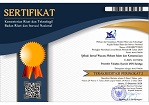An investigation of the relationship between sukuk and the performance of banks of Pakistan
Abstract
Using panel data analysis, this study investigates the relationship among Islamic bonds (Sukuk) and the performance of IB’s of Pakistan for the period of 2008-2017. The study has used two stages approach. At the first stage, the profitability and liquidity of banks have been measured by calculating financial ratios. These ratios were than further used in regression analysis to examine whether a relationship exists between Sukuk and the bank’s profitability and liquidity. Our study found a significant positive relationship among Sukuk and the liquidity of IB’s. While, the results show significant but negative relationship between Sukuk and profitability of IB’s. Based on the findings of the study, we concluded that Sukuk has an important role in enhancing the liquidity of IB’s but it has adverse impact on the profitability of IB’s of Pakistan. Thus, the emergence of Sukuk market may pose threats to the profitability of the IB’s of Pakistan.
Keywords
Full Text:
PDFReferences
Ahmad, N., Daud, S. N., & Kefeli, Z. (2012). Economic Forces and the Sukuk Market. Procedia - Social and Behavioral Sciences, 127 – 133.
Ahmed, E. R., Islam, M. A., Yousif, T. T., & Alabdullah. (2014). Islamic Sukuk: Pricing Mechanism and Rating. Researchgate.
Akhtar, D. S. (2007). Pakistan’s Islamic Banking Sector Review 2003 to 2007.
Alam, N., Hassan, M. K., & Haque, M. A. (2013). Are islamic bonds different from conventional bonds? International evidence from capital market tests. Borsa istanbul review, 22-29.
Alvi, M. I., Rufai, D. A., Dadabhoy, M. I., Khan, M. G., Naseer, M. U., Naseer, M. B., et al. (2014, November). A comprehensive study of the Global Sukuk Market. IIFM.
Bibi, S., & Mazhar, F. (2019). Determinants of bank's profitability & liquidity and the role of BASEL III in islamic & conventional banking sector of pakistan: A case study of NBP. The Economics and Finance Letters, 6(1), 40-56.
Braima, B. H. (2017). Impact of Islamic Securitization (Sukuk) on Islamic Banks Liquidity Risk in Light of Basel III Requirements. Journal of Finance & Banking Studies, VI(1), 85-100.
Elhaj, M. A., Muhamed, N. A., & Ramli, N. M. (2015). The Influence of Corporate Governance, Financial Ratios, and Sukuk Structure on Sukuk Rating. Procedia Economics and Finance, 31(McMillen 2007), 62-74.
Gitman, L. J., & Zutter, C. J. (2012). Principles of Managerial Finance (13th ed.).
Khan, F. A., & Siddiqui, D. A. (2018). Islamic (Sukuk) vs. Conventional Financing: Analysis of Profitability. International Journal of Experiential Learning & Case Studies, 3(2), 246-257.
Lahsasna, A., Hassan, M. K., & Ahmad, R. (2018). Introduction to Sukuk. In Forward Lease Sukuk in Islamic Capital Markets. Palgrave Macmillan, Cham.
Mohamed, H. H., Masih, M., & Bacha, O. I. (2015). Why do issuers issue Sukuk or conventional bond? Evidence from Malaysian listed firms using partial adjustment models. Pacific-Basin Finance Journal, 34, 233–252.
Nagano, M. (2016). Sukuk issuance and information asymmetry: Why do firms issue sukuk? Pacific Basin Finance Journal, 42, 142-157.
Razak, S. S., Saiti, B., & Dinc, Y. (2018). The contracts, structures and pricing mechanisms of Sukuk: A critical assessment. Borsa istanbul review, 1-13.
Reuters, T. (2016). Liquidity Management Through SUKUK Innovative Solutions.
Said, A. (2011). Does the Use of Sukuk (Islamic bonds) Impact Islamic Banks Performances? A Case Study of Relative Performance during 2007-2009. Middle Eastern Finance and Economics(12), 65-76.
Sekaran, U. (2003). Research methods for business (4th edition ed., Vol. 65). New York, USA: John Wiley & Sons.
Smaoui, H., & Khawaja, M. (2016). The Determinants of Sukuk Market Development. Emerging Markets Finance and Trade.
Smaoui, H., Mimouni, K., & Temimi, A. (2017). Sukuk, Banking System, and Financial Markets: Rivals or Complements? Economics Letters, 161.
Vishwanth, S., & Azmi, S. (2009). An Overview of Islamic Sukuk Bonds. THEJOURNAL OF STI(.UCTUREI3 FINANCE, 58-67.
Yesuf, A. J. (2016). A Comparative Analysis of Sukuk and Conventional Bonds. Istanbul, Turkey: Springer International Publishing Switzerland.
Zawya, T. R. (2013). Sukuk perceptions and forecast study. (2014).
Zulkhibri, M. (2015). A synthesis of theoretical and empirical research on sukuk. Borsa istanbul review, 15(4), 237-248.
DOI: https://doi.org/10.18326/ijtihad.v19i1.53-66
Refbacks
- There are currently no refbacks.

This work is licensed under a Creative Commons Attribution-ShareAlike 4.0 International License.
Ijtihad: Jurnal Wacana Hukum Islam dan Kemanusiaan by http://ijtihad.iainsalatiga.ac.id/ is licensed under a Creative Commons Attribution-ShareAlike 4.0 International License







